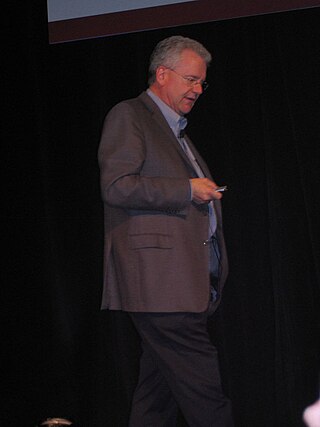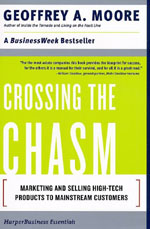
Innovation is the practical implementation of ideas that result in the introduction of new goods or services or improvement in offering goods or services. ISO TC 279 in the standard ISO 56000:2020 defines innovation as "a new or changed entity realizing or redistributing value". Others have different definitions; a common element in the definitions is a focus on newness, improvement, and spread of ideas or technologies.
In business, diffusion is the process by which a new idea or new product is accepted by the market. The rate of diffusion is the speed with which the new idea spreads from one consumer to the next. Adoption is the reciprocal process as viewed from a consumer perspective rather than distributor; it is similar to diffusion except that it deals with the psychological processes an individual goes through, rather than an aggregate market process.
In marketing, the whole product concept is an adaptation of the total product concept developed by Ted Levitt, a professor at Harvard Business School. In his book entitled “The Marketing Imagination” Levitt drew attention to the fact that consumers purchase more than the core product itself. Rather, they purchase the core product combined with complimentary attributes, the majority of which are intangible.
An early adopter or lighthouse customer is an early customer of a given company, product, or technology. The term originates from Everett M. Rogers' Diffusion of Innovations (1962).
In cultural anthropology and cultural geography, cultural diffusion, as conceptualized by Leo Frobenius in his 1897/98 publication Der westafrikanische Kulturkreis, is the spread of cultural items—such as ideas, styles, religions, technologies, languages—between individuals, whether within a single culture or from one culture to another. It is distinct from the diffusion of innovations within a specific culture. Examples of diffusion include the spread of the war chariot and iron smelting in ancient times, and the use of automobiles and Western business suits in the 20th century.

Geoffrey Moore is an American organizational theorist, management consultant and author, known for his work Crossing the Chasm: Marketing and Selling High-Tech Products to Mainstream Customers.
Everett M. "Ev" Rogers was an American communication theorist and sociologist, who originated the diffusion of innovations theory and introduced the term early adopter. He was distinguished professor emeritus in the department of communication and journalism at the University of New Mexico.

Diffusion of innovations is a theory that seeks to explain how, why, and at what rate new ideas and technology spread. The theory was popularized by Everett Rogers in his book Diffusion of Innovations, first published in 1962. Rogers argues that diffusion is the process by which an innovation is communicated over time among the participants in a social system. The origins of the diffusion of innovations theory are varied and span multiple disciplines.
Technological change (TC) or technological development is the overall process of invention, innovation and diffusion of technology or processes. In essence, technological change covers the invention of technologies and their commercialization or release as open source via research and development, the continual improvement of technologies, and the diffusion of technologies throughout industry or society. In short, technological change is based on both better and more technology.
A technology evangelist is a person who builds a critical mass of support for a given technology, and then establishes it as a technical standard in a market that is subject to network effects. The word evangelism is borrowed from the context of religious evangelism due to the similarity of sharing information about a particular concept with the intention of having others adopt that concept. This is typically accomplished by showcasing the potential uses and benefits of a technology to help others understand how they can use it for themselves.

The technology adoption lifecycle is a sociological model that describes the adoption or acceptance of a new product or innovation, according to the demographic and psychological characteristics of defined adopter groups. The process of adoption over time is typically illustrated as a classical normal distribution or "bell curve". The model indicates that the first group of people to use a new product is called "innovators", followed by "early adopters". Next come the early majority and late majority, and the last group to eventually adopt a product are called "Laggards" or "phobics." For example, a phobic may only use a cloud service when it is the only remaining method of performing a required task, but the phobic may not have an in-depth technical knowledge of how to use the service.
Frank M. Bass was an American academic in the field of marketing research and marketing science. He was the creator of the Bass diffusion model that describes the adoption of new products and technologies by first-time buyers. He died on December 1, 2006.
The Bass model or Bass diffusion model was developed by Frank Bass. It consists of a simple differential equation that describes the process of how new products get adopted in a population. The model presents a rationale of how current adopters and potential adopters of a new product interact. The basic premise of the model is that adopters can be classified as innovators or as imitators, and the speed and timing of adoption depends on their degree of innovation and the degree of imitation among adopters. The Bass model has been widely used in forecasting, especially new products' sales forecasting and technology forecasting. Mathematically, the basic Bass diffusion is a Riccati equation with constant coefficients equivalent to Verhulst—Pearl Logistic growth.
In social dynamics, critical mass is a sufficient number of adopters of a new idea, technology or innovation in a social system so that the rate of adoption becomes self-sustaining and creates further growth. The point at which critical mass is achieved is sometimes referred to as a threshold within the threshold model of statistical modeling.
Eco-innovation is the development of products and processes that contribute to sustainable development, applying the commercial application of knowledge to elicit direct or indirect ecological improvements. This includes a range of related ideas, from environmentally friendly technological advances to socially acceptable innovative paths towards sustainability. The field of research that seeks to explain how, why, and at what rate new "ecological" ideas and technology spread is called eco-innovation diffusion.

The technology life-cycle (TLC) describes the commercial gain of a product through the expense of research and development phase, and the financial return during its "vital life". Some technologies, such as steel, paper or cement manufacturing, have a long lifespan while in other cases, such as electronic or pharmaceutical products, the lifespan may be quite short.
In diffusion of innovation theory, a pro-innovation bias is a belief that innovation should be adopted by the whole society without the need for its alteration. The innovation's "champion" has a such strong bias in favor of the innovation, that they may not see its limitations or weaknesses and continue to promote it nonetheless.
The Linear Model of Innovation was an early model designed to understand the relationship of science and technology that begins with basic research that flows into applied research, development and diffusion
The sociological theory of diffusion is the study of the diffusion of innovations throughout social groups and organizations. The topic has seen rapid growth since the 1990s, reflecting curiosity about the process of social change and "fueled by interest in institutional arguments and in network and dynamic analysis." The theory uses a case study of the growth of business computing to explain different mechanisms of diffusion.
Arvind Singhal is an Indian-born American social scientist and academician. His academic research has focused on diffusion of innovations, the positive deviance approach, organizing for social change, the entertainment-education strategy, and liberating interactional structures. He currently holds the positions of Samuel Shirley and Edna Holt Marston Endowed Professor of Communication and Director of the Social Justice Initiative in Department of Communication at University of Texas at El Paso since 2007, William J. Clinton Distinguished Fellow at the Clinton School of Public Service since 2010 and Distinguished Professor 2 in the Faculty of Business Administration, Inland Norway University of Applied Sciences, since 2015.






